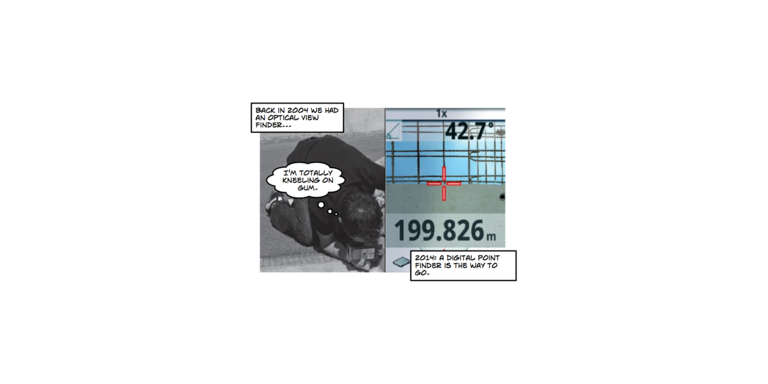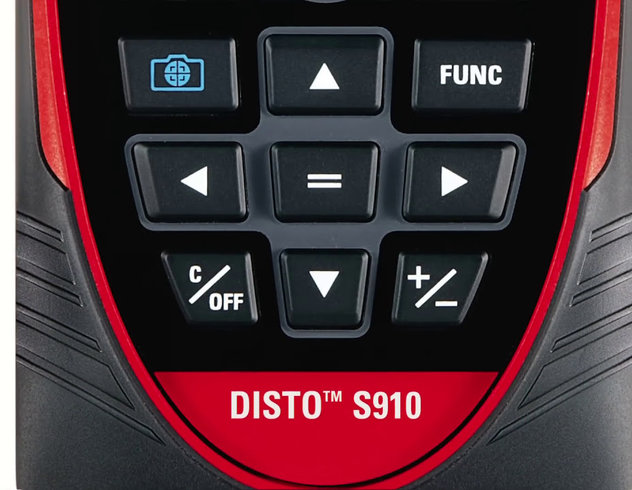When you work outdoors, at long distances, or both, two things need to happen for a laser distance meter (LDM) to work. First, you need to see what the laser beam is actually hitting, and second, the laser measuring "module" needs to receive enough laser signal to get a reading. We'll address laser aiming and visibility in this post and we'll come back to the measurement module in a future post.
There are 4 ways to make your laser spot more visible:
1. Select a light colored target: It's easier to see the laser point at distance against a lighter colored background. Sounds easy—and it is—but it just isn’t possible in a lot of cases.
LDMs are often used to measure in dangerous or inaccessible locations. Let’s say you’re a traffic engineer and need to verify the width of a roadway. If the retaining wall on the other side is made of metal, it’s just not practical or simple to stop traffic and walk across the highway to tape a white piece of paper to the other side.
 |
2. Red laser enhancement glasses: These glasses make the laser beam appear brighter by reducing the ambient light that enters your eyes and filtering for the red light from the laser. The result is that the red beam appears brighter, while the surrounding area seems slightly darker. Though these laser glasses effectively increase the brightness of red laser spot, there is no guarantee that they will enable you to see the red laser spot in all lighting conditions. Do not confuse these with Laser SAFETY Glasses, which do exactly the opposite. Laser safety glasses allow ambient light and BLOCK the red laser light frequency. Cost: from €5 to €30 depending on quality |
|
3. LDM with a built-in Optical Viewfinder: Leica Geosystems offered an optical viewfinder soon after launching the first laser distance meter in 1993, so these have been around almost as long as the handheld laser distance meter itself. In 2003, the first built-in optical viewfinder was introduced in the Leica DISTO Classic 5 with 2x zoom (shown in the photo). This option was extremely popular and more affordable than an external viewfinder. |
 |
Pros
|
Cons
|
Cost: Built into non-Leica LDMs that start at ~ €265
4. LDM with a digital pointfinder: This has been an option since 2006 when the first LDMs that integrated digital camera and zoom technology hit the market.

The early digital viewfinders used 16 shade greyscale displays with 3x zoom but had a slow response. In 2009, the Leica DISTO D5 (pictured) was introduced with the world’s first color digital pointfinder and 4x zoom.
A major limitation of optical viewfinders is that you have to look into the viewfinder and away from the keyboard. The modern digital pointfinder display shows the target, just like the display on a good digital camera, and can be zoomed up to 4x. No stooping over or squinting into the side of the LDM. Just look at the sharp color display to see your measurement point in the crosshairs.
The different zoom stages in the device enable the user to zoom in on the target. The field of view, or the visible area in the display, on the digital viewfinder for a target 65' from the LDM with the integrated pointfinder in the Leica DISTO D510 (E7500i), D810 touch and S910 is documented below. The D810 touch also includes a wide-angle view camera.

(The spots on the 4x zoom picture to the right are the detailed texture of the stucco from 60’ away, not speckle on the display.)
Cost: Digital Viewfinders are available in the Leica DISTO D510 (€549), D810 touch (€779) and S910 (€1399) LDMs.
There you have it! Four ways to save time, money, or both to improve your ability to work outdoors with your laser distance meter. My personal thoughts on the topic? When it comes to tools to do my work, I never regret buying something of good quality and almost always regret buying old technology, even at a bargain price.
Special thanks to Diane Auer, LDM Product Manager at Leica Geosystems, Heerbrugg, Switzerland for her support writing this.
HB



